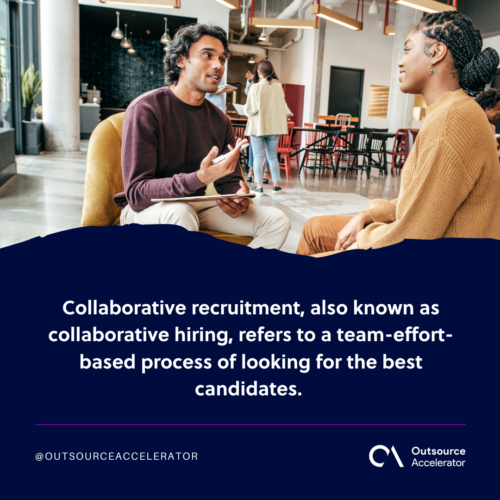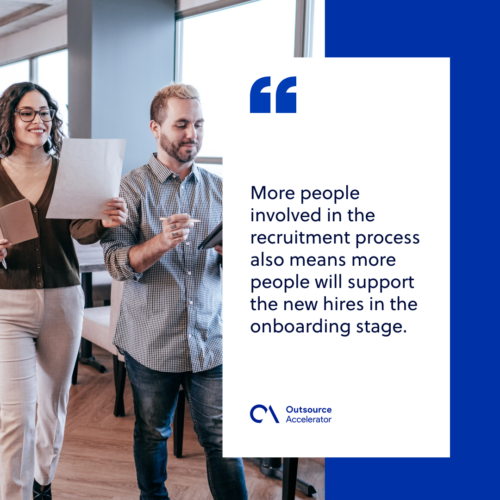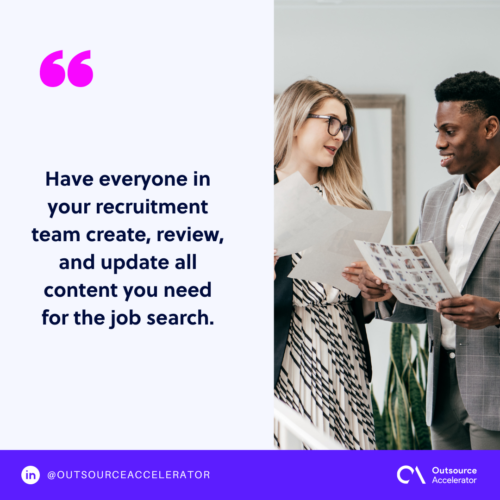Collaborative recruitment 101

You need the right people in your team to help grow your business every step of the way. To gather the perfect sets of expertise to support you in running your business, you need an effective recruitment team.
Traditionally, the hiring process is executed by the human resource department alone. But we all know that trends change, and business landscapes constantly evolve. This includes recruitment and hiring.
At present, organizations adopt a collaborative recruitment approach in hiring the best candidates well-suited to their specific job roles.
In this guide, we will discuss the fundamentals and stages of collaborative recruitment. We will also uncover the benefits your organization can get out of shifting into this recruitment model.
A quick overview of collaborative recruitment
Collaborative recruitment, also known as collaborative hiring, refers to a team-effort-based process of looking for the best candidates.
It involves various members of the organization, business leaders, and other team members in workplace collaboration.
Collaborative recruitment has become an integral part of every company’s hiring strategy in modern times. Staff members involved can share their inputs regarding individual candidates. The more feedback, the more you will have an elaborate candidate evaluation process.
For businesses with limited time and resources, besides collaborative recruitment, one option is to outsource their talent recruitment to premier third-party service providers like ConnectOS.
They can leverage effective recruitment processes to hire top talents, while they focus on their core business functions.

What can your organization get from collaborative recruitment?
Here’s how you can leverage a collaborative recruitment approach:
Diversity in points of view
Having different perspectives helps your organization in identifying the specific job roles and ideal applicants you need. It also helps determine the possible issues that may happen in the future.
Diversity and different points of view from staff or stakeholders reduce the chances of hiring bad talents.
Smooth onboarding
More people involved in the recruitment process also means more people will support the new hires in the onboarding stage. These people will also have a sense of responsibility in training, assisting, and helping newcomers get acquainted with their new roles.
Improved company culture
When everyone in the company works together, it says a lot about the company culture. Collaborative recruitment promotes a good working environment and allows employees to cultivate a harmonious relationship with each other.
More importantly, this lets employees know that their voice and inputs are also vital in the administration.

Stages of the collaborative recruitment process
Now that you have an idea of what collaborative recruitment is and its advantages, let’s jump right into the process.
Here are the steps to take for a successful collaborative recruitment process:
Recruitment preparation
Have everyone in your recruitment team create, review, and update all content you need for the job search. This includes the job description for the specific role, different templates for each stage, ideal candidate persona, and your job advertisement.
You can also ask for input from your staff with the same job functions as what you are looking to hire. This way, you will have a better understanding of their tasks, responsibilities, and required skill set.
Looking for the right candidates
In collaborative recruitment, you can also implement an employee referral program. It allows your in-house staff to recommend qualified candidates within their network.
Apart from recommendations, they can also help the organization find the best talents by sharing your job post online.

Candidate selection
Before you get to this stage, ensure that your hiring criteria are clear and in line with your specific job requirements. You can also work with the entire team in preparing interview questions.
It is also good to have each member of the recruitment team assess candidates according to their areas of expertise. Make use of scorecards; this lets you have a transparent and more streamlined process.
Hiring
During the hiring stage, gather all your recruitment team members and discuss each of your chosen candidates. Ensure that everyone can share their opinions, impressions, and assessment for each applicant.
Onboarding newly hired candidates
Onboarding newly hired employees is a critical and final stage of your collaborative recruitment process. In-house staff is essential in helping new hires adjust to their new company and job role.
During onboarding, you can set up a buddy system. Doing so lets new hires learn more about their job functions, colleagues, and different departments within the organization. More importantly, a buddy program helps new hires easily adapt to your work culture.
Find the perfect fit with collaborative recruitment
Collaborative recruitment doesn’t only help you hire the right individuals for a specific job position but also the whole company. Start planning out your collaborative recruitment process today!







 Independent
Independent




